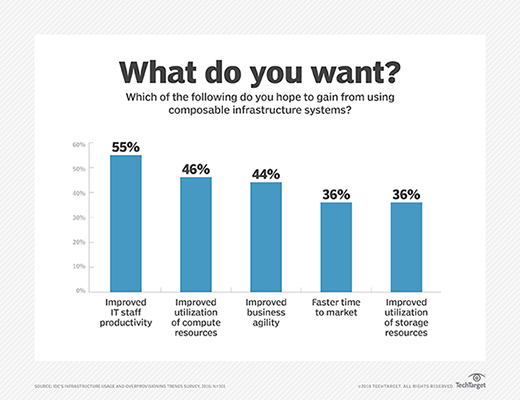
Petya Petrova - Fotolia
Is HCI but a stop on the road to composable architecture?
Find out if composable infrastructure is the next step in the evolution of HCI, if it is a completely different type of IT infrastructure or if the truth is somewhere in between.
There is an entire spectrum of computing options -- traditional, converged and hyper-converged -- available for the on-premises, private cloud, public cloud and multi-cloud worlds. Today, there's a newer entrant in the data center architectural realm. Dubbed composable architecture -- or infrastructure -- it's a step beyond what we're seeing with other data center technologies.
Let's explore how by first taking a look at today's more established data center infrastructures:
- Traditional: This is an architecture in which you have separate silos of storage, compute and networking. Management of each of these resources is handled separately. Customers buy the pieces and assemble them all.
- Converged: At first glance, converged infrastructure looks a lot like the traditional world, but as you peel back the layers, you'll discover that these architectures are intentionally built with ease of management in mind. They're often shipped as a single unit in a rack, ready to go. The customer can more easily manage these environments compared to traditional ones, and the deployment is dead-simple.
- Hyper-converged: With this visible departure from the past, various elements -- compute, storage and, increasingly, networking -- are all collapsed into single appliances. Multiple appliances are cabled together to form complete clusters that run virtual machines. In general, software-defined storage and networking form the basis for these structures.
Hyper-convergence has been a boon for many organizations, with a number of positive outcomes, such as improved operational efficiency and lower overall TCO. The biggest challenges for some enterprises have been how these environments scale and their inability to support physical workloads that either don't work in virtualized environments or aren't well-suited to such environments. Furthermore, there has been frustration around the need to scale hardware linearly. For example, if you need more storage, why can't you just add more storage? Although some hyper-converged infrastructure (HCI) platforms are now enabling this, it's not as common as some would like.
This is where the next phase of the data center journey comes into play: composable infrastructure. With composable architecture, all resources are software-defined, with a centralized composer handling all control plane activities. The actual hardware -- the data plane -- is managed by this central controller.
With composable architecture, the controller can create any combination of resources necessary to build workload operating environments, whether those are bare-metal or virtual hosts. Composable infrastructure is flexible enough to handle both.

As HCI has evolved, it has become clear that the line between hyper-converged and composable has blurred. We see companies, such as Cloudistics, Datrium and NetApp, releasing what some consider platforms that are HCI in name only and look a whole lot more like composable architecture environments.
Personally, I do see a future in which most, if not all, HCI products will look and act more like composable infrastructure, although there may still be differentiation in how physical workloads are handled. HCI doesn't support physical workloads, in general, while composable architecture does.
Regardless, it's clear there is much innovation ahead for HCI, and customers are the ones who will benefit.








